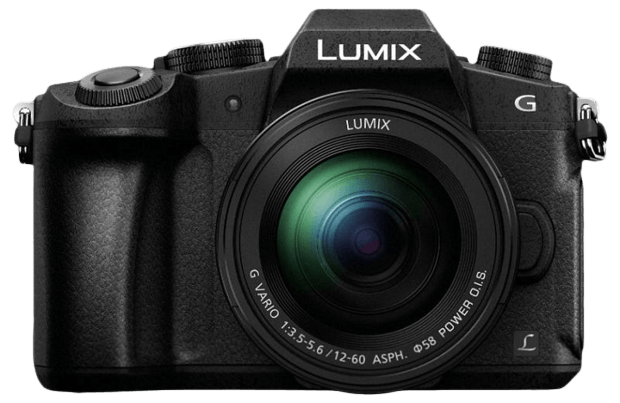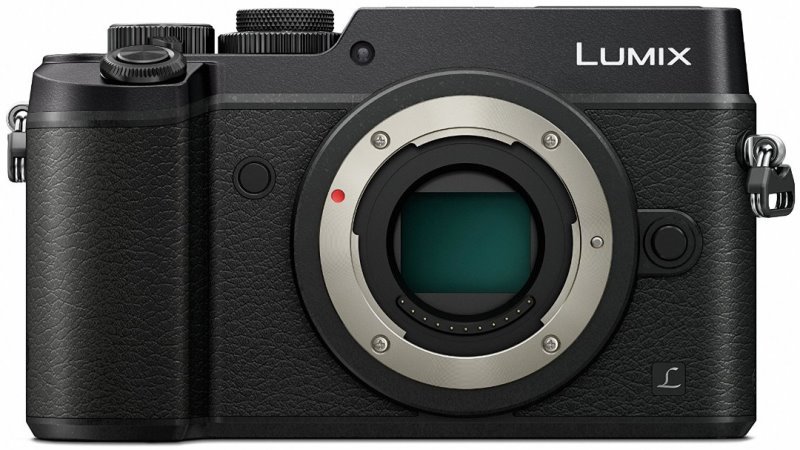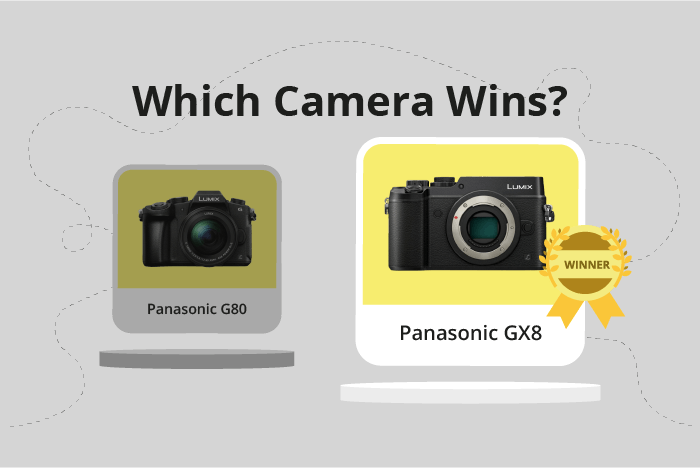Panasonic Lumix DMC-G80 vs Lumix DMC-GX8 Comparison
Panasonic Lumix DMC-G80

Panasonic Lumix DMC-GX8

The Panasonic Lumix DMC-GX8 takes the lead with a score of 63/100, while the Panasonic Lumix DMC-G80 trails slightly behind at 58/100. Both cameras are mirrorless and were released in 2015 and 2016, respectively. They share similar features, such as launch prices of $1200 and $900, and similar sizes – the GX8 measures 133 x 78 x 63mm, while the G80 is 128 x 89 x 74mm.
The GX8 has a slight advantage in terms of weight, coming in at 487g, while the G80 weighs 505g. However, the G80 is more affordable, which could be a deciding factor for some buyers. Each camera has its strengths and weaknesses, but ultimately, the choice will depend on the individual’s preferences and budget.
Panasonic Lumix DMC-G80 vs Lumix DMC-GX8 Overview and Optics
The Panasonic Lumix DMC-GX8 outperforms the Panasonic Lumix DMC-G80 in optics with a score of 65/100 compared to the G80’s 57/100. Both cameras share several specifications, including a CMOS sensor type, Venus Engine processor, Micro Four Thirds sensor size, Micro 4/3 lens mount, and image stabilisation.
The GX8 excels with its higher megapixel count of 20.3 compared to the G80’s 16 megapixels. This difference allows the GX8 to capture more detail and produce higher resolution images. Additionally, the GX8 has a faster shooting speed of 10 frames per second, compared to the G80’s 9 frames per second, enabling it to capture fast-moving subjects more effectively. The GX8 also has a higher DXOMARK score for the sensor at 75, compared to the G80’s score of 71, indicating better overall image quality.
On the other hand, the G80 does not necessarily outshine the GX8 in any specific optical aspect. However, it still provides decent image quality and performance with its 16 megapixels, 9 frames per second shooting speed, and a DXOMARK sensor score of 71.
Taking these points into consideration, the Panasonic Lumix DMC-GX8 stands out as the superior camera in terms of optics, with its higher resolution, faster shooting speed, and better sensor performance. While the Panasonic Lumix DMC-G80 may not surpass the GX8 in any particular optical aspect, it remains a reliable and capable camera for various photography needs.
Panasonic Lumix DMC-G80 vs Lumix DMC-GX8 Video Performance
The Panasonic Lumix DMC-GX8 outperforms the Panasonic Lumix DMC-G80 in video capabilities with a score of 70/100 compared to the G80’s 56/100. Both cameras share common specifications, such as 4K max video resolution and 3840 x 2160 max video dimensions. However, there are key differences that make the GX8 a better choice for video recording.
The GX8 has a better max video frame rate of 25fps, while the G80 offers 30fps. The lower frame rate of the GX8 allows for smoother motion and less motion blur, making it more suitable for capturing fast-moving subjects or action scenes. Additionally, the GX8 has a built-in time-lapse functionality, which the G80 lacks. This feature enables users to create stunning time-lapse videos without the need for additional equipment or software.
On the other hand, the G80 has a higher max video frame rate of 30fps, which can be advantageous for certain situations, such as capturing slow-motion footage. However, this advantage is relatively minor compared to the benefits offered by the GX8.
Taking into account the video capabilities of both cameras, the Panasonic Lumix DMC-GX8 is the superior choice for videographers due to its smoother motion capture and built-in time-lapse functionality. While the G80 offers a higher max video frame rate, it falls short in other aspects and does not provide the same level of video performance as the GX8.
Panasonic Lumix DMC-G80 vs Lumix DMC-GX8 Features and Benefits
The Panasonic Lumix DMC-G80 and the Panasonic Lumix DMC-GX8 both have a feature score of 70/100, making it a tie in this comparison. These cameras share several specifications, including a 3-inch screen size, 1040000-dot screen resolution, touchscreen functionality, flip screen, and WIFI connectivity. Neither camera has GPS or Bluetooth capabilities.
The Lumix DMC-G80 and DMC-GX8 have many similarities, making it difficult to determine a clear winner. Both cameras have the same screen size and resolution, ensuring that users can view their images with the same level of detail. The touchscreen feature on both cameras allows for easy navigation of the menu and settings. The flip screen feature is beneficial for capturing shots at different angles and for vlogging purposes. Additionally, both cameras have WIFI, which makes transferring images to other devices quick and simple.
Despite the similarities, there may be some differences in other aspects of these cameras that could sway a buyer’s decision. However, based on the provided specifications, there is no clear winner in terms of features. As a result, potential buyers should consider other factors such as price, design, and additional specifications to make an informed decision.
In this comparison, both the Panasonic Lumix DMC-G80 and the Panasonic Lumix DMC-GX8 offer the same level of features. This makes it challenging to declare a winner solely based on the specifications provided. Buyers should explore other factors and personal preferences to determine which camera best suits their needs.
Panasonic Lumix DMC-G80 vs Lumix DMC-GX8 Storage and Battery
The Panasonic Lumix DMC-G80 and the Panasonic Lumix DMC-GX8 both score 21/100 in storage and battery. They share the same specifications in this category, with each camera having one memory card slot that accepts SD, SDHC, and SDXC cards. Both cameras have a battery life of 330 shots and use lithium-ion batteries. Neither camera offers USB charging.
The G80 and GX8 are equal in terms of storage and battery performance. There are no specific advantages for either camera in this category, as they share the same features and have the same score. The lack of USB charging in both cameras may be a disadvantage for some users who prefer on-the-go charging options.
Considering both cameras have the same storage and battery specifications, there is no clear winner in this category. Users can expect similar performance from either the Panasonic Lumix DMC-G80 or the Panasonic Lumix DMC-GX8 in terms of storage and battery life.
Alternatives to the Panasonic Lumix DMC-G80 and Lumix DMC-GX8
Are you still undecided about which camera is right for you? Have a look at these popular comparisons that feature the Panasonic Lumix DMC-G80 or the Panasonic Lumix DMC-GX8:

